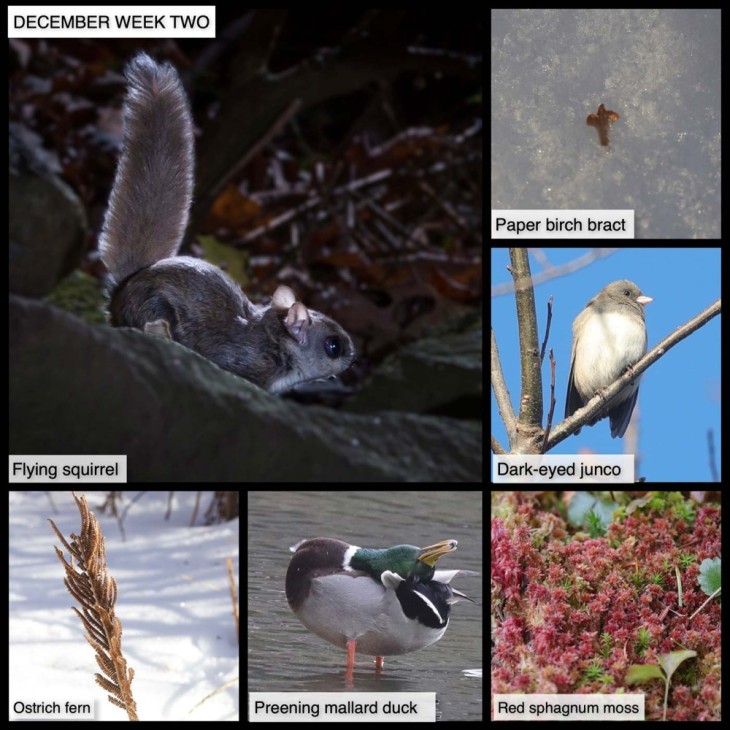This Week in the Woods, we’ve been spying on flying squirrels (they appear to be southern flying squirrels) in a barn. These beautiful little animals, not much bigger than chipmunks, are fairly common, but they’re nocturnal and rarely seen. Unlike slightly larger northern flying squirrels, which typically stick to conifer stands, southern flying squirrels thrive in a variety of habitats, including attics and outbuildings. Here’s an Outside Story article about both species by Madeline Bodin. The essay shares a cool vocabulary word, patagium – the skin flap between their front and back legs that enables the squirrels to glide – and notes that this feature comes at the cost of body heat loss. In the winter, they often sleep together in large groups: for example, cuddling together in a tree cavity.
Here are some other nature sights from this week (clockwise):
If you’ve walked under paper birches recently, chances are you’ve seen fleur-de-lis shaped bracts on the snow. These are tiny, modified leaves attached to even tinier seeds, and they aid in the seeds’ dispersal. Unlike fruit-bearing trees that exploit wildlife to spread their seeds, birches use wind and crusted snow. On a cold, gusty morning, you can witness this in action, as the seed-bearing bracts go for windborne toboggan rides.
How do dark-eyed juncos and other winter birds stay warm? One tactic, demonstrated in this photo, involves fluffing up the feathers, which traps warm air next to the body. Limiting activity, packing on the calories, roosting in tree cover or other shelter that offers insulation and huddling together are all also common ways they conserve energy. Here’s an Audubon profile for juncos, which we’ve been seeing and hearing much more often recently, as they forage in large flocks in snow-covered meadows. In summer these are mostly forest birds, but this time of year you can find them in many different habitats.
And here are some photos from our archive:
As the temperature drops, red sphagnum moss is getting rosier. There’s more than one species; our best guess is that the moss in the photo is probably Sphagnum capillifolium, which according to the Princeton Field Guides’ Common Mosses of the Northeast and Appalachians, has a dome-like growth form and tends to grow in especially acidic, nutrient-poor environments.
Mallard ducks will linger in the region longer than most migratory waterfowl; pretty much as long as there’s food and open water. In winter, if you’re lucky, you may see examples of synchronous preening, when multiple ducks contort themselves into all kinds of silly poses in order to spread oil around their feathers (necessary for maintaining waterproof plumage). Last year, we shared this amazing video from the KQED San Francisco “Deep Science” video series showing magnified images of the water-proofing structures in feathers, and explaining how preening works. As noted in the video, “Every time a duck runs its bill down a feather, it zips its [feather] barbs back together again.”
Finally, if you’re feeling a bit depressed by the long nights and lack of outside color, you may take some cheer from the brown fertile fronds of ostrich ferns, and mark their location on a map to return for (sustainable, please!) fiddlehead harvesting next spring. Here’s a short article from the Spring 2021 issue of Northern Woodlands by Todd McLeish, which explains what sustainable harvesting means, and looks ahead to a new book on DIY fiddlehead farming.
Our thanks to The Bailey Charitable Foundation and the Frank and Brinna Sands Foundation for helping to support this series.
In this difficult period, many of us find joy in observing local nature. This series, launched in April 2020, shares nature photographs taken in the past seven days, or in the same week in 2020, most within 15 miles of the Northern Woodlands office in Lyme, New Hampshire. We hope you enjoy using this grid as a prompt for your own explorations.
What are you seeing in the woods this week? Share your images with us on Facebook, or submit a special photo for possible inclusion in our monthly online Reader Photo Gallery.


